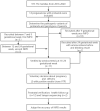Noninvasive prenatal diagnosis based on cell-free DNA for tuberous sclerosis: A pilot study
- PMID: 35429229
- PMCID: PMC9266619
- DOI: 10.1002/mgg3.1952
Noninvasive prenatal diagnosis based on cell-free DNA for tuberous sclerosis: A pilot study
Abstract
Background: Noninvasive prenatal diagnosis (NIPD) based on cell-free DNA (cfDNA) has been introduced into the clinical application for some monogenic disorders but not for tuberous sclerosis (TSC) yet, which is an autosomal dominant disease caused by various variations in TSC1 or TSC2 gene. We aimed to explore the feasibility of NIPD on TSC.
Methods: We recruited singleton pregnancies at risk of TSC from 14 families with a proband child. Definitive NIPD for TSC was performed using targeted next-generation sequencing of cfDNA in parallel with maternal white blood cell DNA (wbcDNA). The NIPD results were validated by amniocentesis or postnatal gene testing and follow-up of the born children.
Results: Missense mutations, nonsense mutations, frameshift mutations, and splice-site variants which were obtained through de-novo, maternal, or paternal inheritance were included. The mean and minimum gestational weeks of NIPD were 17.18 ± 5.83 and 8 weeks, respectively. The NIPD results were 100% consistent with the amniocentesis or postnatal gene testing and follow-up of the born children.
Conclusion: This study demonstrates that NIPD based on cfDNA is feasible for TSC, but required to be confirmed with more samples. Studies on TSC can contribute to the application and promotion of NIPD for monogenic disorders.
Keywords: autosomal dominant disease; cell-free DNA; monogenic disorder; noninvasive prenatal diagnosis; tuberous sclerosis.
© 2022 The Authors. Molecular Genetics & Genomic Medicine published by Wiley Periodicals LLC.
Conflict of interest statement
The authors report no conflict of interest.
Figures


Similar articles
-
Detection of TSC1/TSC2 mosaic variants in patients with cardiac rhabdomyoma and tuberous sclerosis complex by hybrid-capture next-generation sequencing.Mol Genet Genomic Med. 2021 Oct;9(10):e1802. doi: 10.1002/mgg3.1802. Epub 2021 Sep 4. Mol Genet Genomic Med. 2021. PMID: 34480426 Free PMC article.
-
[Genetic screening and prenatal diagnosis in high-risk families with tuberous sclerosis complex syndrome].Zhonghua Yi Xue Yi Chuan Xue Za Zhi. 2021 May 10;38(5):435-438. doi: 10.3760/cma.j.cn511374-20200325-00203. Zhonghua Yi Xue Yi Chuan Xue Za Zhi. 2021. PMID: 33974250 Chinese.
-
[Diagnosis of tuberous sclerosis complex focusing on prenatal period].Ceska Gynekol. 2016 Apr;81(2):147-54. Ceska Gynekol. 2016. PMID: 27457398 Czech.
-
Non-invasive prenatal diagnosis and screening for monogenic disorders.Eur J Obstet Gynecol Reprod Biol. 2020 Oct;253:320-327. doi: 10.1016/j.ejogrb.2020.08.001. Epub 2020 Aug 7. Eur J Obstet Gynecol Reprod Biol. 2020. PMID: 32907778 Review.
-
Identification of TSC2 mosaic mutation limited to cortical tuber with TSC targeted sequencing: a case report and literature review.Childs Nerv Syst. 2021 Dec;37(12):3945-3949. doi: 10.1007/s00381-021-05059-1. Epub 2021 Jan 30. Childs Nerv Syst. 2021. PMID: 33517515 Review.
Cited by
-
Mechanistic strategies for secondary prevention of developmental and epileptic encephalopathy in children with tuberous sclerosis complex.EBioMedicine. 2025 Jun;116:105740. doi: 10.1016/j.ebiom.2025.105740. Epub 2025 May 13. EBioMedicine. 2025. PMID: 40367637 Free PMC article. Review.
References
-
- Au, K. S. , Williams, A. T. , Roach, E. S. , Batchelor, L. , Sparagana, S. P. , Delgado, M. R. , Wheless, J. W. , Baumgartner, J. E. , Roa, B. B. , Wilson, C. M. , Smith‐Knuppel, T. K. , Cheung, M. Y. C. , Whittemore, V. H. , King, T. M. , & Northrup, H. (2007). Genotype/phenotype correlation in 325 individuals referred for a diagnosis of tuberous sclerosis complex in the United States. Genetics in Medicine, 9(2), 88–100. 10.1097/gim.0b013e31803068c7 - DOI - PubMed
-
- Dang, M. , Xu, H. , Zhang, J. , Wang, W. , Bai, L. , Fang, N. , Liang, L. , Zhang, J. , Liu, F. , Wu, Q. , Wang, S. , & Guan, Y. (2019). Inferring fetal fractions from read heterozygosity empowers the noninvasive prenatal screening. Genetics in Medicine, 22(2), 301–308. 10.1038/s41436-019-0636-5 - DOI - PMC - PubMed
Publication types
MeSH terms
Substances
LinkOut - more resources
Full Text Sources
Medical

